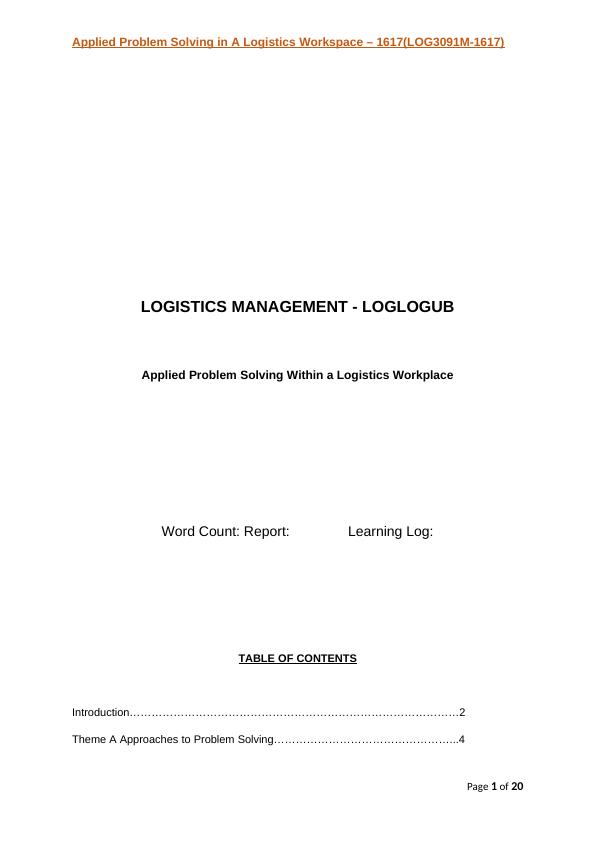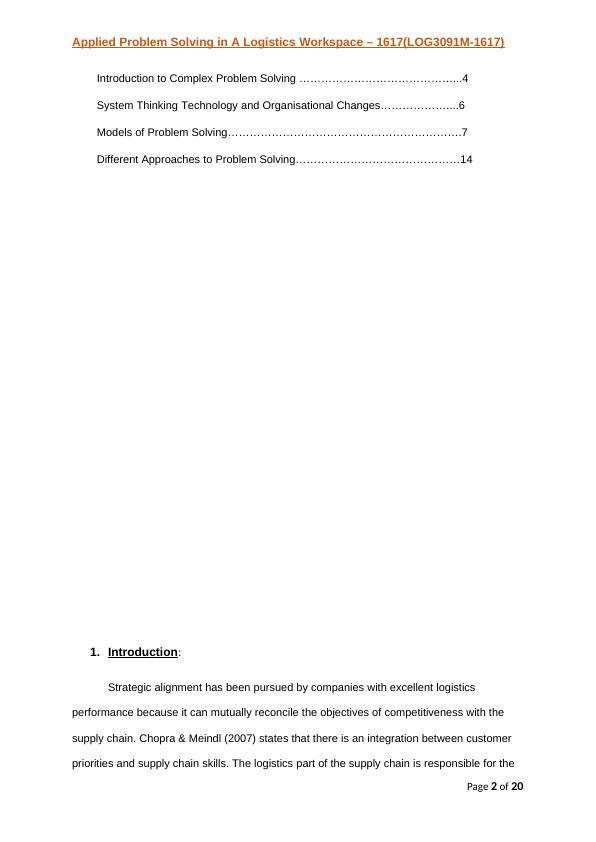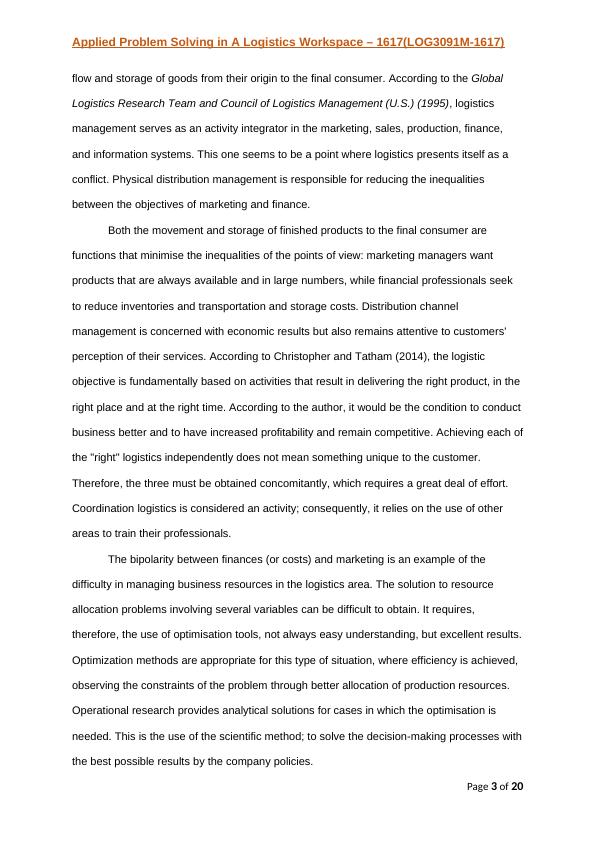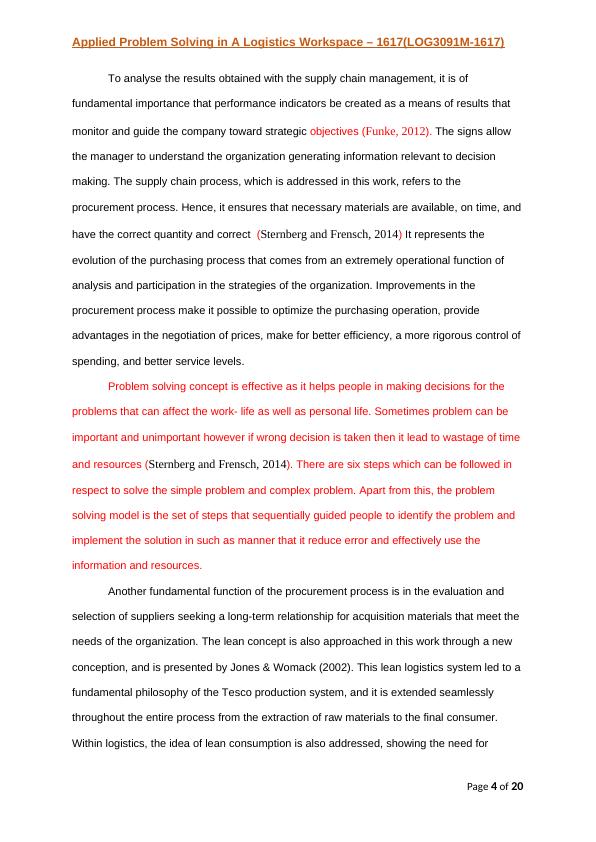Applied Problem Solving in a Logistics Workspace
Added on 2020-06-04
20 Pages6069 Words119 Views
Applied Problem Solving in A Logistics Workspace – 1617(LOG3091M-1617)LOGISTICS MANAGEMENT - LOGLOGUBApplied Problem Solving Within a Logistics WorkplaceWord Count: Report: Learning Log:TABLE OF CONTENTSIntroduction..........................................................................................2Theme A Approaches to Problem Solving...................................................4Page 1 of 20

Applied Problem Solving in A Logistics Workspace – 1617(LOG3091M-1617)Introduction to Complex Problem Solving .............................................4System Thinking Technology and Organisational Changes......................6Models of Problem Solving................................................................7Different Approaches to Problem Solving.............................................141.Introduction:Strategic alignment has been pursued by companies with excellent logistics performance because it can mutually reconcile the objectives of competitiveness with the supply chain. Chopra & Meindl (2007) states that there is an integration between customer priorities and supply chain skills. The logistics part of the supply chain is responsible for the Page 2 of 20

Applied Problem Solving in A Logistics Workspace – 1617(LOG3091M-1617)flow and storage of goods from their origin to the final consumer. According to the Global Logistics Research Team and Council of Logistics Management (U.S.) (1995), logistics management serves as an activity integrator in the marketing, sales, production, finance, and information systems. This one seems to be a point where logistics presents itself as a conflict. Physical distribution management is responsible for reducing the inequalities between the objectives of marketing and finance.Both the movement and storage of finished products to the final consumer are functions that minimise the inequalities of the points of view: marketing managers want products that are always available and in large numbers, while financial professionals seek to reduce inventories and transportation and storage costs. Distribution channel management is concerned with economic results but also remains attentive to customers' perception of their services. According to Christopher and Tatham (2014), the logistic objective is fundamentally based on activities that result in delivering the right product, in the right place and at the right time. According to the author, it would be the condition to conductbusiness better and to have increased profitability and remain competitive. Achieving each ofthe "right" logistics independently does not mean something unique to the customer. Therefore, the three must be obtained concomitantly, which requires a great deal of effort. Coordination logistics is considered an activity; consequently, it relies on the use of other areas to train their professionals. The bipolarity between finances (or costs) and marketing is an example of the difficulty in managing business resources in the logistics area. The solution to resource allocation problems involving several variables can be difficult to obtain. It requires, therefore, the use of optimisation tools, not always easy understanding, but excellent results.Optimization methods are appropriate for this type of situation, where efficiency is achieved, observing the constraints of the problem through better allocation of production resources. Operational research provides analytical solutions for cases in which the optimisation is needed. This is the use of the scientific method; to solve the decision-making processes withthe best possible results by the company policies.Page 3 of 20

Applied Problem Solving in A Logistics Workspace – 1617(LOG3091M-1617)To analyse the results obtained with the supply chain management, it is of fundamental importance that performance indicators be created as a means of results that monitor and guide the company toward strategic objectives (Funke, 2012). The signs allow the manager to understand the organization generating information relevant to decision making. The supply chain process, which is addressed in this work, refers to the procurement process. Hence, it ensures that necessary materials are available, on time, andhave the correct quantity and correct (Sternberg and Frensch, 2014) It represents the evolution of the purchasing process that comes from an extremely operational function of analysis and participation in the strategies of the organization. Improvements in the procurement process make it possible to optimize the purchasing operation, provide advantages in the negotiation of prices, make for better efficiency, a more rigorous control ofspending, and better service levels. Problem solving concept is effective as it helps people in making decisions for the problems that can affect the work- life as well as personal life. Sometimes problem can be important and unimportant however if wrong decision is taken then it lead to wastage of time and resources (Sternberg and Frensch, 2014). There are six steps which can be followed in respect to solve the simple problem and complex problem. Apart from this, the problem solving model is the set of steps that sequentially guided people to identify the problem and implement the solution in such as manner that it reduce error and effectively use the information and resources. Another fundamental function of the procurement process is in the evaluation and selection of suppliers seeking a long-term relationship for acquisition materials that meet the needs of the organization. The lean concept is also approached in this work through a new conception, and is presented by Jones & Womack (2002). This lean logistics system led to afundamental philosophy of the Tesco production system, and it is extended seamlessly throughout the entire process from the extraction of raw materials to the final consumer. Within logistics, the idea of lean consumption is also addressed, showing the need for Page 4 of 20

End of preview
Want to access all the pages? Upload your documents or become a member.
Related Documents
Logistics & Supply Chain Managementlg...
|11
|1447
|79
Fundamentals of Logistics and Supply Chain | Reportlg...
|13
|2792
|19
SCM Resourceslg...
|4
|996
|127
Business Operation and Logistics Review 2022lg...
|14
|3045
|50
Understanding Operations, Logistics and Supply Chain Managementlg...
|12
|3442
|95
Supply Chain Management in Marks & Spencerlg...
|10
|2960
|69